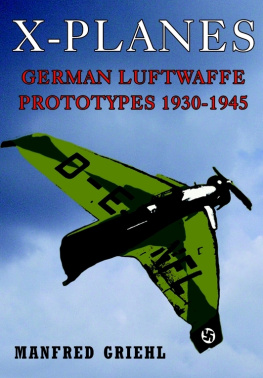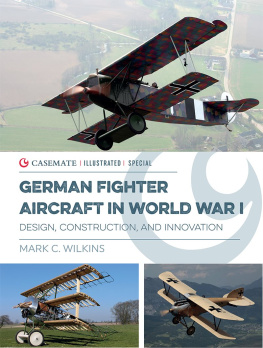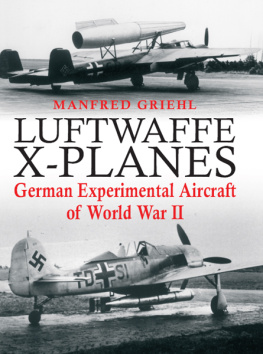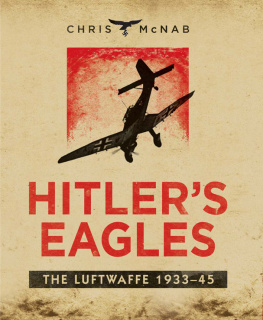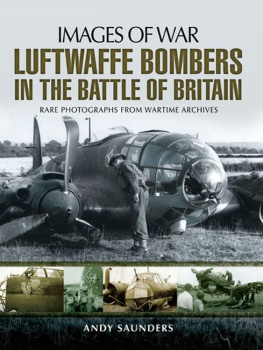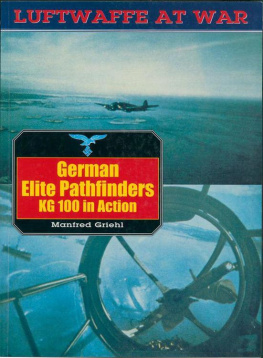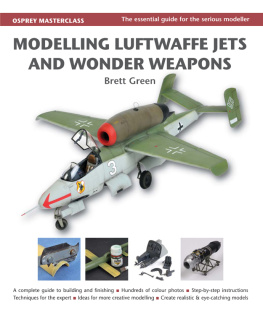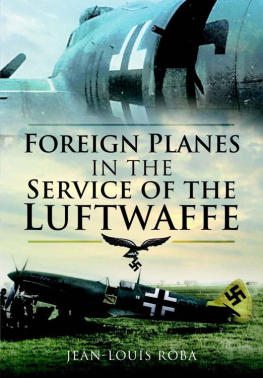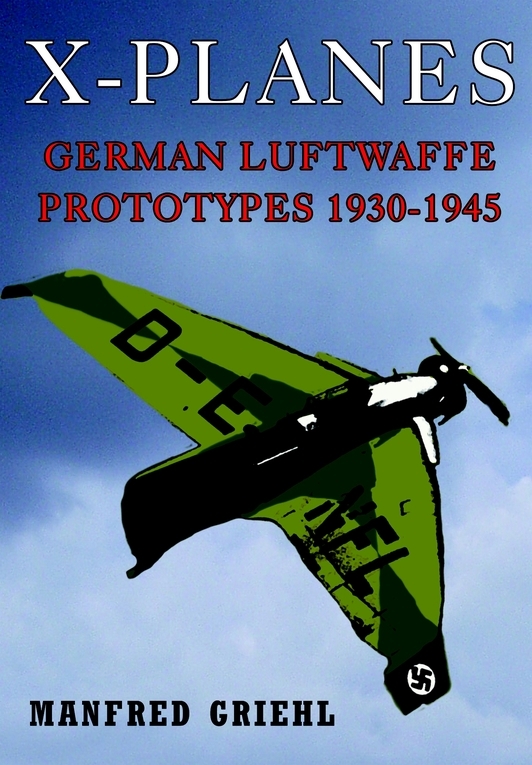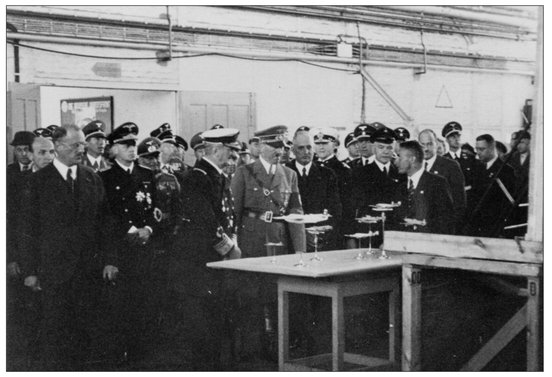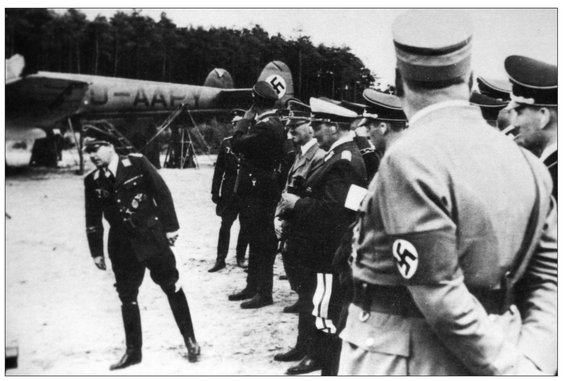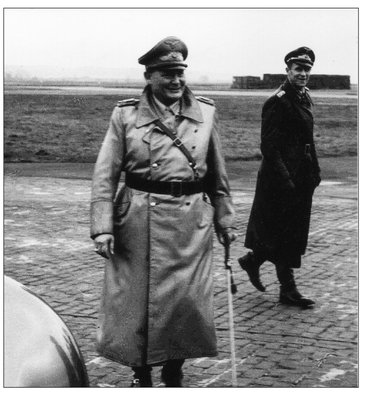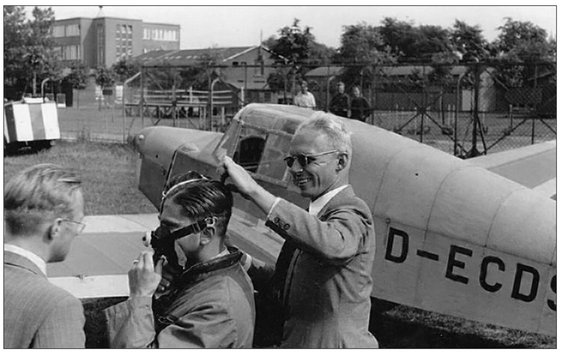Aircraft Development by the RWM and RLM
After its defeat in World War I the former German Reich was forced to carry out the development and evaluation of its future civil and military aircraft under conditions of the strictest secrecy. A number of new designs, particularly warplanes, were tested by German pilots and crews at bases in Italy, Sweden and the Soviet Union. Once the Allies had lifted their ban on the production of civil machines in Germany, several military types were developed under the guise of commercial airliners or civil courier aircraft.
Until 1933 everything relating to civil aviation came under the control of the Weimar governments Reichsverkehrsministerium (Reich Ministry of Transport), while all military aviation matters were the (clandestine) responsibility of the Reichswehrministerium (RWM: Reich Ministry of Defence).
Adolf Hitler being briefed about new aircraft projects by Dr.-Ing. Vogt during a visit to the
Blohm und Voss works at Hamburg-Finkenwrder. (Nowarra)
Hitler and Hermann Gring together with Ernst Udet during the presentation of a tethered
Bf 110 pre-series aircraft used for the testing of fixed weapons. (Nowarra)
In the immediate aftermath of World War I Germany had been strictly prohibited from developing military aircraft in any form. Although Allied controls were rigorous, the German government initially supported by the Soviet Union covertly set about laying the foundations for a secret new arm, which became known as the Risikoluftwaffe (literally Risk Air Force). Unbeknown to the Allied Control Commission, design bureaux all over the Reich were engaged in drawing up plans for a whole raft of new and modern fighters, bombers and reconnaissance aircraft. Between 1 March 1920 and 31 March 1927 the Reichswehrministerium, more specifically the Heeresleitung (Army High Command), established the so-called Truppenamt (L) (Armed Forces Office/Air), which then became directly responsible for all matters pertaining to military aviation, including personnel, equipment and organization. This office supervised the development and manufacture of all new military aircraft types and oversaw their subsequent flight-testing at Lipezk, a large secret airbase in the Soviet Union that was operated jointly by the Germans and the Russians over a period of many years.
In 1924 the Reichswehrministerium set up the Amtsgruppe Waffenbeschaffung (Department of Weapons Procurement). Under a Chefinspekteur Waffen und Gert (Chief Inspector of Weapons and Equipment) this Amtsgruppe was divided into a number of sub-departments, one of which Wa B 6F, headed by Hauptmann Volkmann was initially responsible for the procurement of all aircraft, aircraft engines and ancillary equipment. In 1929, however, this responsibility passed directly to the control of the head of the RWMs Heereswaffenamt (Army Ordnance Directorate).
Thereafter Hauptmann Volkmann, erstwhile head of Wa B 6F, was appointed controller of the Amtsgruppe Entwicklung (Development Department) of the RWM. One of his subordinates was the then Hauptmann Jeschonnek (later to become the Luftwaffes first Chief of General Staff), who was himself in charge of six sub-departments: aircraft, engines, general equipment, weapons and ordnance, reconnaissance equipment and wireless-telegraphy. Volkmann also controlled the RWMs first Erprobungsstelle (Test Centre; usually abbreviated to E-Stelle), which had been established at Rechlin, as well as the test facility code-named Albatros. But the officer directly responsible for the overall procurement of aircraft and equipment was Hauptmann Seidner, who was also head of the Bauaufsicht Luft (BAL: Works Quality Control/Air).
As of 1 October 1929 (and until 31 March 1933), Wa Prw 8 a section of the newly reorganized Waffenprfwesen (Armaments Test Department) under Major Wimmer was itself divided into five further sub-groups:
The Reichsluftfahrtministerium (RLM) building in the centre of the Berlin. (LMG)
Reichsmarschall Hermann Gring, an ace fighter pilot of World War I, became the head of the RLM, but could not solve all the problems in his ministry. (Haberfellner)
| Gruppe 1 | Development of aircraft | Hauptmann Konrad |
| Gruppe 2 | Development of equipment | Hauptmann Ploch |
| Gruppe 3 | Test establishments | Massenbach |
| a) Rechlin |
| b) Albatros |
| c) Staaken |
| d) Lipezk |
| Gruppe 4 | Provision of all Luftwaffe aircraft and equipment | Hauptmann Seidner |
| Gruppe 5 | Wehrwirtschaft and Rstung (military economy and armament) | Wegner |
It was thus under the aegis of the Weimar government that the various offices and departments mentioned above laid the foundations for Germanys new air arm. It was they who ordered the first aircraft to be built, who organized their testing (either at home or abroad) and who selected the most suitable and promising designs to enter operational service.
However, shortly before the assumption of power of Adolf Hitler and his Nazi Party, the RWM set up a separate Reichsluftfahrtministerium (RLM: Reich Air Ministry), soon to be headed by Hermann Gring. And on 1 June 1933 the RLM was in turn divided into a Luftschutzamt (LA: Air Defence Department) and an Allgemeines Luftamt (LB: General Aviation Department); the latter being headed by the famous World War I fighter pilot Ernst Udet, who was subsequently to become the Staatssekretr der Luftfahrt (Secretary of State for Aviation). Udets office initially consisted of five sub-departments: LB I (Air Transport), LB II (Technical Development), LB III (Sports Flying and Training), LB IV (Aerial Photography) and LB V (Ground Organization). Only three months after that, on 1 October 1933, the RLM underwent further reorganization, being split into six major departments:
| Department ZA | Zentralabteilung | Central Office |
| Department LA | Luftkommandoamt | Operations Department |
| Department LB | Allgemeines Luftamt | General Department |
| Department LC | Technisches Amt | Technical Department |
| Department LD | Luftwaffenkommandoamt | Luftwaffe Command Department |
| Department LP | Luftwaffenpersonalamt | Luftwaffe Personnel Department |
Most aircraft evaluation took place in the facilities of the different producers. This photo
shows preparations for a high-altitude trial with an Si 202 at Halle. (Lange)

